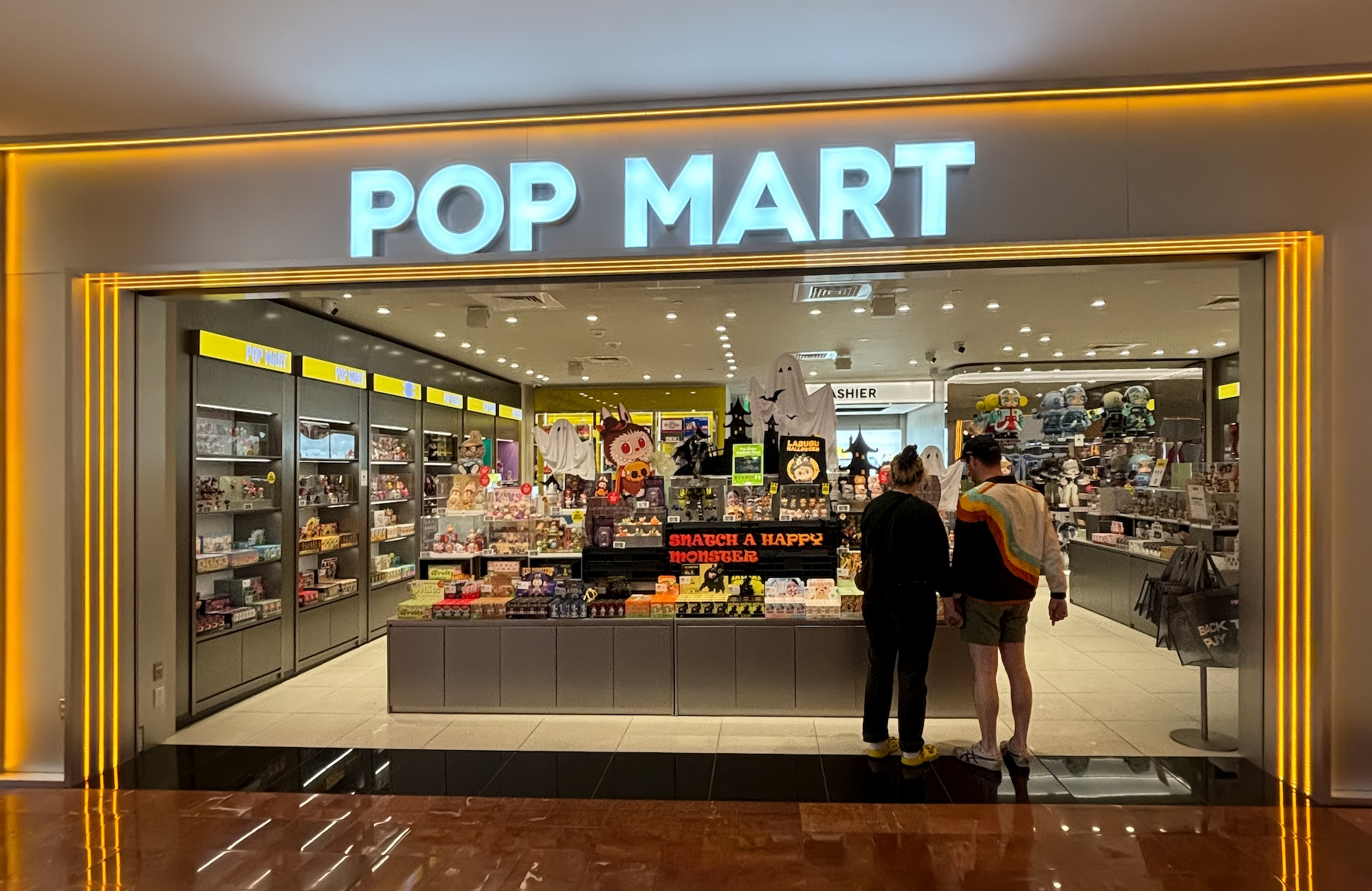C+CT talked with experts in such areas as leasing, marketing, brokerage and technology for a debrief on some of the trends that shaped 2024 and a look at logical strategies for 2025. They covered opportunities like the rising demand for space among global chains like Mango, Miniso and Pop Mart; the growing role of location-based data in the Marketplaces Industry; how marketers can capitalize on digital natives’ passion for real-world experiences; and efforts to reinvent and densify older malls. They also pointed to the need for restaurants to ramp up appeal to price-sensitive diners, explained how retailers can fend off growing legal threats over their discounting practices, outlined steps that landlords and municipalities can take to keep distressed properties from going under and described new tech tools that could help control the intractable problem of high construction costs.
Pacific Retail Capital Partners’ Najla Kayyem

Young people are flocking to the likes of vinyl records, pinball arcades and throwback thrift stores, a trend that stands to create more opportunities for malls and mixed-use properties in 2025, said Pacific Retail Capital Partners executive vice president of marketing Najla Kayyem. “You’re increasingly seeing this conscious effort to recapture and prioritize face-to-face interactions, with malls being cool again,” she said. “It’s really being fueled by the digitally native generation, which sees novelty in anything pre-digital.”
Kayyem’s oversight of marketing for PRCP mall redevelopments over the past year has been geared toward making these properties more engaging. “Most of the malls that we work with were built at Main and Main and have strong reasons to exist within the community,” she said, “but they might need some TLC, capital and elbow grease to make a bigger impact.”

This past November, Pacific Retail Capital Partners and Synergy Construction broke ground on the mixed-use transformation of Yorktown Center in the Chicago suburbs. Plans call for scraping its former Carson’s department store building to make way for new shops, restaurants and 600 or so residential units. The additions to the 12-acre site will surround a one-acre green space and community park. Retailers that are open or on the way include The Fresh Market, Dave & Buster’s, Tapville Social, Ancho & Agave and Empire Burgers + Brew.
But Kayyem is focused on the evolution of the digital world, as well. “We’re witnessing, like it or not, the emergence of AI influencers and digital personas that are making an impact on the way people interact with brands online and shop and explore,” she explained. “So this year, we will be developing and testing an AI persona to personalize and provide support for tenants and enhance the consumer experience.” The online content will be sharable among various PRCP properties. Meanwhile, she will explore ways to ramp up tenant sales and traffic via livestream shopping. “The QVC-ification of social media platforms like TikTok Shop has really started to come to light,” she said.
Kayyem, who also runs her own eponymous independent marketing agency, sees no contradiction in these simultaneous focuses on the throwback worthy and the futuristic. Over the past 25 years, her work has touched the likes of CityNorth in Phoenix; The Americana at Brand in Glendale, California; and The Grand LA and Westfield Century City, both in Los Angeles. “No one way is the right way,” she said. “You have to constantly test and evolve and innovate while always staying focused on best practices and the basics.”
Synergy Restaurant Consultants’ Danny Bendas

At the beginning of 2024, U.S. restaurants were hiking prices to protect their margins in the face of rising costs, but said Synergy Restaurant Consultants managing partner Danny Bendas, cash-strapped consumers could take only so much. “The year ended with consumers saying: ‘Wait a minute. Why am I paying all this money in this QSR place, and why am I having to tip everybody?’”
Many quick-service restaurant chains scrambled to offer cheap boxes and meals ranging from $4 to $7. “Their guest counts were down because people were struggling with the idea of paying $12 or $14 for a fast-food experience,” he noted.
The pricing pressure contributed to bankruptcy filings by restaurants of all stripes, from Red Lobster, Buca di Beppo and TGI Fridays to Rubio’s Coastal Grill, a trend Bendas predicted will continue in 2025. “We’re at an inflection point in the industry,” he said. “There are just too many restaurants, and it is getting harder to find talented labor without paying too much for it.”
In the year ahead, he said, restaurants should bear in mind that “the biggest challenges and the biggest opportunities will relate to value and efficiency.” That could mean ferreting out waste in areas like product, supply chain, labor, technology, operations and equipment. “Rule No. 1 is that you cannot sacrifice quality or the guest experience.”
Value is about more than price alone, Bendas maintained. Operators like Chick-fil-A, Texas Roadhouse and Chili’s thrive in part because they offer a better overall experience, focusing sharply on guest service, he said. “If you had to focus on something really big in 2025, it’s training and culture. Innovating is great, but stay true to yourself. Sometimes restaurants forget who they are and end up doing things that don’t fit their concept. Keep it simple and stay on brand.”
Akerman’s Ellen Robbins

Akerman partner and trial lawyer Ellen Robbins tracks legal threats against retailers. Over the past year, the litigator observed an uptick in legal actions against retailers regarding so-called “perpetual discounts” and other deceptive pricing tactics. “Plaintiffs’ firms are increasingly monitoring this and using software to automate the process,” she said.
Under Federal Trade Commission regulations, retailers are required to charge any “reference price” — i.e., the original, higher amount that serves as the basis for an advertised discount — for “a reasonable period of time” within the past 90 days, Robbins explained. Throughout 2024, plaintiffs’ firms routinely sued retailers for advertising items as, say, 30% off without following the 90-day rule. The allegation is that “such practices amount to false advertising, unfair business practices and unfair competition,” she explained.
But compliance is a gray area. Even if a discounted item was offered at its original reference price within 90 days, Robbins explained, there are no definitive rulings on how long it needs to have been available at that higher price. “If you advertise something at $100 for just one out of those 90 days, then most likely that reference price would be deemed not in good faith and insufficient,” the attorney explained. “But does it need to be available at that price for 70 days, or for half of the 90-day period? It is unclear.”
In addition to “perpetual sales” claims, plaintiffs’ firms have accused retailers of setting false deadlines for sale expirations. To give shoppers a false sense of urgency, they might trumpet “Sale Ends at Midnight!” but then keep it going. Other lawsuits accuse retailers of falsely suggesting that outlet merchandise came from mainline stores when in fact it was specially manufactured for the outlet channel, Robbins noted. “Not only are retailers exposed to potential damages from these lawsuits, but being sued for deceptive pricing also can result in significant PR damage.”
In the year ahead, retailers can count on more scrutiny of their pricing practices. As Robbins sees it, they should consult with legal experts to ensure that they are protecting themselves and complying with the law. The attorney recommended keeping a promotions calendar that documents those good-faith efforts to maintain compliance. And when shoppers join loyalty programs or make online purchases, retailers could require them to agree to legally enforceable arbitration clauses and class-action lawsuit waivers. “The plaintiff’s lawyers want easy, quick cash and want to spend their time on clear violations,” Robbins said. “If you have a defensible pricing strategy, the issue is more likely to go away quickly.”
Placer.ai’s Ethan Chernofsky

Tech firms often race ahead, seeking to disrupt established industries, but Placer.ai senior vice president of marketing Ethan Chernofsky said novel uses of his company’s foot-traffic analytics platform have come from slowing down and listening to real estate professionals. “If I’m talking to someone who has been a retail broker for 30 years, they don’t need me to explain to them how the world of brokerage is going to change,” he said. “I need to ask them what they need to drive that change. What is missing from the puzzle?”
TechCrunch reported this past August that Placer.ai’s valuation had reached $1.5 billion. The company now boasts more than 4,300 customers globally with a client list that includes Wegmans, Regency Centers, Cushman & Wakefield, Marcus & Millichap, BJ’s, Raising Cane’s and Unibail-Rodamco-Westfield. Reaching $100 million in annual revenue was one of Placer.ai’s 2024 milestones, Chernofsky noted. “Especially in the tech ecosystem, there can be an over-orientation toward the amount of money you raise [versus actual revenue]. It showed that there’s a validity to how we operate and execute.”
Users commonly employ the platform to analyze traffic, competitors and trade areas; find sites; bolster marketing campaigns; and prepare for negotiations. However, new uses continue to emerge. Chernofsky pointed to one that came from asking real estate researchers about their jobs. “They were spending hours a day making brochures and doing things like plotting data points in images. We said: ‘What if we built a tool to shrink down all of this manual design?’”
Listening sessions also helped shape a Placer.ai tool that matches retail stores with consumer packaged goods brands and helped mold a program to generate more ad revenue from the digital marketing displays and other “consumer impressions” in retailers’ portfolios.
Other new Placer.ai capabilities are internally driven and hard won. It took years of trial-and-error for the company’s research and development team to develop an accurate way to measure shopper visits lasting fewer than five minutes, an update that launched in 2024. “For Starbucks, a two-minute visit could be significant,” Chernofsky said. “It really matters to be able to show that kind of visit, especially as buy-online-pick-up in store gets more seamless.”
When Placer.ai launched in 2018, doubts about the long-term future of retail were running high. Over the past couple of years, Chernofsky said, “that has completely flipped. Now people are starting to say: ‘OK, there’s not a lot of retail space available. Now what?’”
Exploring that question with real estate pros will be part of Placer.ai’s focus in 2025, he said. “The combination of creativity and confidence is going to drive a lot of big ideas, and we hope to be a key part of the solution that powers them.”
Brookfield Properties’ Mark Blackwell

Global brands helped drive leasing across Brookfield Properties’ 129-asset U.S. retail portfolio in 2024, said executive vice president of leasing Mark Blackwell. The list includes Mango, from Spain; Miniso and Pop Mart, both from China; and Aritzia, Garage and Arc’teryx, all from Canada. “Retailers know that the U.S. is a great market and a place where they can open really successful stores, and we’re happy to help them do that,” Blackwell said.
Some international mall tenants have ramped up their expansions after operating in the states for years. Blackwell pointed to 2024 Brookfield Properties deals with Canada’s Lululemon, Japan’s Uniqlo, the U.K.’s JD and Spain’s Zara. Other global operators are relative newcomers. Pop Mart, for one, opened its first U.S. store in 2023, and hundreds queued up this past July when it opened at Brookfield Properties’ Stonestown Galleria in San Francisco. “We have probably done 20 deals or so alone with Pop Mart within the last six months,” Blackwell noted.

Beijing-based Pop Mart opened a location in Brookfield Properties’ Stonestown Galleria in San Francisco in July. The retailer sells art toys and collectibles, often in “blind boxes” that add mystery and fun to the purchase. Photo by Nick Fochtman and courtesy of Brookfield Properties
Pop Mart wasn’t the only tenant to sign recently at the 600,000-square-foot Stonestown Galleria, which Brookfield renovated in 2023. Located about 10 miles from downtown, the two-level mall boasts more than 90 tenants and “had a great leasing year,” Blackwell said, noting that this owed in part to retailers taking space after shuttering their downtown San Francisco stores.
Over the summer, the San Francisco Board of Supervisors also approved a Brookfield Properties plan to add 3,500 homes to the site. As Blackwell sees it, the company’s densification efforts continue to pay off.
“When we add residential, entertainment or food-and-beverage, dwell time goes up significantly.”
An example is Atlanta’s Cumberland Mall, where the 900,000 square feet of retail is 100% leased. “We invested nearly $70 million to redevelop the former Sears Auto building and add 327 residential units,” he said. “This really complemented our separate redevelopment of the former Sears department store box, where we added a Golf Galaxy, as well as a Planet Fitness and a Round1 Bowling & Arcade.” Other tenants at Cumberland Mall include Apple, Sephora, H&M, Maggiano’s Little Italy and The Cheesecake Factory. “When we add residential, entertainment or food-and-beverage, dwell time goes up significantly,” Blackwell said. “It has been a really successful model for us.”
In the year ahead, Blackwell aims to do more deals with expanding global retailers. Meanwhile, Brookfield is keeping an eye on interest rates with a view toward cranking up the bulldozers again. “We are making plans as we speak. When rates get more manageable — and they’re heading in the right direction — we’ll be geared up to expand.”
California State University, Fresno’s Manideep Tummalapudi

Retailers and developers continued to face frustratingly high construction costs in 2024 due to factors like sagging labor productivity, ongoing supply chain snarls and unnecessary rework, said California State University, Fresno construction management professor Manideep Tummalapudi. Budget-busting real-world examples of the latter include redoing botched plumbing installations, reframing mismeasured walls, reinstalling incorrectly sized windows and tearing out and repouring weaker-than-specified concrete, Tummalapudi noted. “The United States construction industry now spends nearly $65 billion a year on construction rework alone.”
The professor, who advises contractors on improving efficiency, said technologies like building information modeling, modular construction, lidar and artificial intelligence-powered applications can help.
AI tools can optimize project timelines by simulating construction sequences and then pointing to the most efficient ways to proceed, he said. Vision-based AI systems can “detect discrepancies between designs and actual work, which minimizes costly rework.” Other platforms use 3D scanning and AI to monitor jobsite progress and generate reports in minutes instead of days. “These innovations streamline tasks and allow contractors to focus on critical decisions rather than administrative work,” he said.
Another area showing promise is modular construction, in which companies prefabricate components are off-site and then smaller crews assemble them rapidly on-site, yielding big savings on labor costs. “The housing crisis, workforce shortages, sustainability goals and the need to reduce delays and cost overruns are some of the biggest challenges facing the industry,” Tummalapudi said. “Modular construction can address all of these.”
Yet he encouraged retailers and developers to make sure their construction contractors invest in people, not just technology. “Many construction companies focus heavily on new technologies and process improvements but neglect workforce development,” Tummalapudi explained. “If your team doesn’t know how to use these tools effectively, productivity gains will remain elusive.”
NAI Farbman’s Ronald Goldstone

NAI Farbman executive vice president Ronald Goldstone is bullish about the 2025 prospects of best-located retail, office and mixed-use properties in Michigan. The story no doubt is the same across the country. “If anything, they are healthier than they have ever been,” he said. But the Farmington Hills-based broker said retail and office properties below the top-tier class face challenges in terms of leasing and investment sales. “The gap has grown deeper than I’ve ever seen it between A, B, C and D properties.”
The culprits on the retail side include daunting construction costs, a smaller number of expanding chains and, to a lesser extent, today’s still-high capital costs. In some Michigan markets, Goldstone noted, construction costs for store builds that once would have run $80 or less per square foot have been reaching $200 or even $300 per foot. Meanwhile, “the retailers that are out seeking locations have become exceptionally selective,” the broker said.
To cope with these challenges in 2025, the Marketplaces Industry will need to “roll up their sleeves and be supercreative,” Goldstone said. His advice: Build a multidisciplinary project or company team to connect with potential users and to seek partnerships with forward-thinking municipalities.
Sitting down with public officials and talking to them about the realistic prospects of lower-tier assets, in particular, could be a smart move, he added. “They need to accept uses that may not have been their first choice five, seven or 10 years ago,” Goldstone said. “I still scratch my head when it comes to some of these assets. They are sitting empty and have failing roofs, there’s an interested party, and yet the city still says: ‘No, we don’t want the use.’”
In the cyclical real estate economy, even a hard-hit property is likely to rebound eventually, and so, Goldstone said, landlords with enough financial wherewithal should consider being flexible with tenants, too. “The concept of blend-and-extend can be a mutually beneficial pathway,” he explained. “Let’s say the tenant occupies 30,000 square feet with a year of remaining term but in reality only needs about 20,000 square feet. As a landlord, you can take the burden off that existing tenant by signing a new lease for 20,000 square feet for five or six years and then finding a new tenant for that remaining 10,000 feet.”
By Joel Groover
Contributor, Commerce + Communities Today